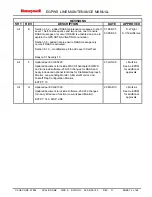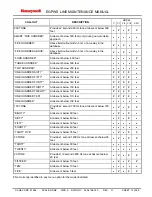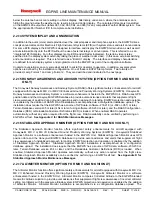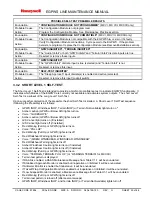
EGPWS LINE MAINTENANCE MANUAL
CAGE CODE: 97896
SCALE: NONE SIZE: A
DWG NO.: 060-4199-180
REV: G
SHEET 15 of 68
When an aircraft penetrates either the TCF or the RFCF alert envelope, the aural message “TOO LOW TERRAIN”
will occur. This aural message will occur once when initial envelope penetration occurs, and one time thereafter for
each 20% degradation in either Altitude (AGL) or Altitude (ASL) depending on which envelope was violated (TCF or
RFCF respectively). EGPWS cockpit alert annunciations remain illuminated until the alert envelope is exited. The
TCF and RFCF functions are not available in the MK XXII.
2.2.9.1 RUNWAY DATABASE
The EGPWS Runway Database consists of data records for all airport runways offered for the coverage provided by
the Terrain Database. For the MK V and MK VII, all hard surface runways in the world 3500 feet or greater in length
are supported. For the MK VI, all runways 2000 feet or greater in length within the database region installed are
supported. The MK VIII has the ability to select >2000 foot or >3500 foot runway lengths. For the MK XXII, only
runways 2000 feet or greater with a published approach procedure are included. The database provides the means
of accessing the records of runways closest to the current aircraft position.
2.2.10 TERRAIN ALERTING AND DISPLAY (OPTIONAL)
The Terrain Alerting and Display (TAD) function monitors aircraft position with respect to local database-cataloged
terrain to provide rapid audio and visual alerts when a terrain threat is detected. Terrain threats are recognized and
annunciated when terrain violates specific computed envelope boundaries forward of the aircraft path. The terrain
database also includes obstacles (when and where available) providing similar annunciations when cataloged
obstacles violate the same envelope boundaries.
Terrain Alerting outputs (lights and audio) behaves in the same manner as the standard GPWS mode alerts. Either
caution or warning alerts will initiate a specific audio alert phrase. The caution aural is “CAUTION TERRAIN” or
“CAUTION OBSTACLE” and the warning aural is “TERRAIN, TERRAIN, PULL UP” or “OBSTACLE, OBSTACLE,
PULL UP” (minor variations exist).
Complementing the terrain threat alerts, the EGPWS also maintains a synthetic image of local terrain forward of the
aircraft for display on EFIS Navigation Displays (ND’s), Multi-Functional Displays (MFD’s), or Weather Radar
Indicators. The EGPWS may be configured to automatically de-select the Weather Display and pop-up a display of
the terrain threats when they occur. The logic used for these configurable controls also provides an external input
for predictive windshear alerts that can override a Terrain Display and revert to the weather display with the
corresponding windshear data.
The EGPWS provides up to two optional external displays outputs, each with independent range-scaling control in
the same fashion as weather radar with more than one indicator. Changes of range scaling to one display do not
affect the other display. Each of these two independent outputs may be used to drive more than one display.
2.2.10.1 TERRAIN AND OBSTACLE DATABASE
The EGPWS Terrain Database is the earth’s surface divided into grid sets and cells referenced to the geographic
(latitude/longitude) coordinate system of the World Geodetic System 1984 (WGS-84). Elements of the grid sets
include the highest terrain altitude (above MSL) in each cells respective area. Grid sets vary in resolution
depending on geographic location. Because the overwhelming majority of “Controlled Flight Into Terrain (CFIT)”
accidents occur near an airport, and the fact that aircraft operate in closer proximity to terrain near an airport, higher
resolution grids are used around airports. Lower resolution grids are used outside of airport areas where aircraft
altitude enroute makes CFIT accidents unlikely and for which detailed terrain features are not important to the flight
crew.
Digital Elevation Models (DEM’s) are available for most of the airports around the world today. In cases where data
is not currently available, DEM’s are generated from available topographic maps, sectional charts, and airline
approach plates. The process of acquiring, generating, assembling, and updating the database is governed by strict
configuration controls to insure the highest level of data integrity for generation of the EGPWS Terrain Database.
The EGPWS Terrain Database is organized in a flexible and expandable manner. Using digital compression
techniques, the complete database is stored in non-volatile memory within the LRU. Updates and additions are
easily accomplished via a PCMCIA card interface.




































